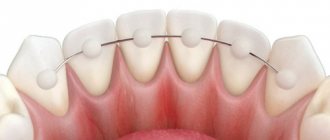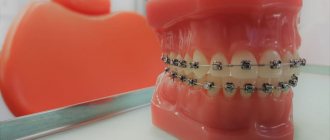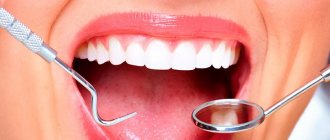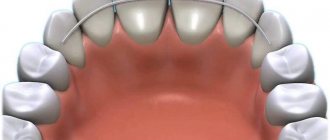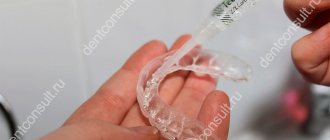28.11.2019
At the moment when the doctor informed the patient that the treatment process is over and that the braces system can be removed, teeth whitening after removing the braces becomes the most significant and important aspect for the client of the dental clinic. This is explained simply, because having received the desired result in the form of an even and beautiful row of teeth, the patient often faces unpleasant side effects in the form of stains on the tooth enamel. To get rid of such troubles, it is necessary to perform whitening so that no plaque or tartar remains on the teeth.
Is it possible to whiten teeth after braces?
It is not difficult to understand a patient who, after removing braces, suddenly discovers spots of different colors on his teeth; his desire to whiten looks quite natural. Of course, you can whiten your teeth after removing braces, but you will have to wait a little, about a month, before starting this procedure. By the way, there are also situations when a specialist recommends increasing the waiting period due to the individual characteristics of the patient’s oral cavity and the poor condition of his teeth. Whitening is based on a chemical reaction, as a result of which the released active oxygen penetrates the upper layers of the teeth and brightens them. Such an intervention is stressful, hence some pain experienced by the patient after its completion.
In any case, there is no need to rush, even if the appearance of the jaw is so smooth and beautiful because of its color. There are two important aspects that support this statement:
- during the waiting period, the enamel will be restored and will no longer be depleted and weak;
- the natural color of some areas can be restored without external aggressive intervention.
How to do whitening?
The teeth whitening procedure is one of the most effective and highly popular among dental patients. Its rather high cost is not the most pleasant moment, but the result obtained justifies all financial investments and costs.
When contacting a dentist with a similar problem, you can count on the following methods to solve the problem:
- hygienic cleaning with the help of which removes plaque and tartar, and also restores the natural color of the enamel;
- laser cleaning, which requires perfect cleanliness but gives excellent results;
- the use of special whitening strips that remove the yellow color of teeth and return them to their natural color.
Advantages and disadvantages of whitening
The key advantage of the whitening procedure is manifested in a person’s beautiful snow-white smile. In addition, yellow teeth are not only not very beautiful, but also not very stable, and this is not only a problem with the appearance of the teeth. Whitening makes it possible to get rid of plaque and tartar, prevents the growth of bacteria in the oral cavity, and accordingly the risk of developing caries is reduced.
However, whitening also has disadvantages, in particular the likelihood of certain complications, which are not difficult to avoid; it is necessary to visit the dentist in a timely manner to diagnose the condition of the enamel.
Pros and cons of the procedure
Whitening is a popular service in dental clinics. Like all dental services, this procedure has its advantages and disadvantages that should be considered before undergoing it.
Advantages:
- Creating a beautiful smile with white teeth.
- Removing stone and plaque prevents the development of caries.
- High efficiency.
- Duration of the result.
Flaws:
- There is a high risk of increased tooth sensitivity.
- After the procedure, it is necessary to limit the consumption of coloring products.
- Whitening will not work on filled teeth or dentures.
What is special about Avalon polyurethane braces and what defects can be corrected with their help.
In this publication, we will take a closer look at the ligature brace systems from Cassis.
Here https://zubovv.ru/ortodontiya/breketyi/vestibulyarnyie/kompozitnyie-nadezhnyih-sposob.html we will discuss the pros and cons of composite braces.
Why is there a need for teeth whitening?
A very common unpleasant surprise for patients who have undergone treatment with braces, which is not possible to predict in advance, is a change in color in areas of the enamel not covered by the system. The most likely cause of such unattractive stains is eating foods with dyes, smoking and insufficient attention to oral hygiene. The bracket system serves as reliable protection against darkening, but after its removal, a real color imbalance is observed, which has to be restored with the help of bleaching.
Restrictions when wearing braces
Wearing braces imposes certain restrictions not only on nutrition, but also on lifestyle. In general, the recommendations are not burdensome, but it is important to follow them so that your teeth remain straight, healthy and beautiful. These include:
- Fights. Children, of course, are more susceptible to this. It is recommended to reduce conflicts to a verbal truce, since blows can move the structure.
- Restrictions in sports: for example, you cannot engage in martial arts (boxing, karate and others).
- Quitting smoking and nail biting habits.
- Complete refusal of chewing gum.
The first time after installing braces, you may experience discomfort, but the discomfort will go away after 7-10 days. The patient will have to endure some inconvenience and endure the listed restrictions, but the reward for this will be straight, healthy teeth and a beautiful smile.
Three ways to solve the problem
The problem of darkened enamel can cause serious inconvenience not only after removing the structure, but also during its wearing. In this case, the option of removing the system and performing teeth whitening is acceptable, but this is only permissible in a frankly advanced case, as well as if the patient has very decent funds, because you will have to pay for the additional work of a specialist. In all other situations, there are two other ways: teeth whitening after removing braces professionally or at home.
Features of teeth whitening after orthodontic treatment
There are many different methods that can successfully answer the question of how to whiten teeth, but not all of them are suitable for a patient who has just finished wearing braces. That is why it is so important to carry out this procedure only with the help of a specialist, using exclusively professional techniques. Each person has his own individual characteristics of the mucous membrane and enamel; accordingly, the selection of the necessary whitening gel, its composition and the concentration of the necessary substances in it must be carried out by a specialist. If this aspect is ignored, then the lack of the expected result will be less of a nuisance, but it will be much worse if serious damage is caused to the enamel.
Note: It should be understood that for teeth, especially if they have been damaged or weakened after installing and removing the braces, whitening is a serious stress.
Therefore, teeth whitening after removing braces should be performed no earlier than a month after their removal, so that the enamel has time to strengthen and the teeth to adapt to the new shape. True, whitening is not required in all situations; it happens that it will be quite enough to remove plaque without resorting to more radical solutions.
Summarizing all of the above, we can formulate three key rules for teeth whitening after the braces are removed:
- Use only professional techniques.
- You can start whitening after removing the system after a month.
- It does not always make sense to perform whitening; after consultation with a doctor, you can limit yourself to professional teeth cleaning.
What hygiene products are there for braces?
Modern manufacturers produce a huge number of various products and devices that provide complete oral hygiene and high-quality care for braces. The most popular and effective among them are:
- V-shaped brushes. They differ in the shape and location of the villi, ensuring penetration even under the braces.
- Multi-tuft brushes. Such designs are designed to eliminate plaque in the interdental space. The hardness of the pile is of great importance.
- Cleaners. This is a pen-holder with a metal rod, into which nylon pile is woven. The working element can be conical or cylindrical, and the user decides which shape is more convenient for him.
- Irrigators. This device removes plaque using a jet of water. Water is supplied from a special container built into the handle of the device.
- Flosses. These are special dental flosses that allow you to clean not only the space between the teeth, but also the elements of the system.
Types of teeth whitening after removing braces
Existing teeth whitening techniques can rightfully be called unique and specific, but they all have common features:
- The whitening procedure should be preceded by a diagnosis of the enamel and its condition, because if it is severely weakened, then chemical intervention will cause even more harm to it, accordingly, it will first need to be strengthened;
- in all cases, a key role is played by a special gel made taking into account the individual characteristics of the patient;
- the basis of the bleaching agent is made up of chemical elements such as hydrogen and carbonate peroxide, the concentration of which is approximately 20%;
- the whitening effect is achieved due to the release of active oxygen that penetrates the enamel as a result of a chemical reaction;
- Upon completion of whitening, it is necessary to perform procedures to strengthen the top layer of teeth.
The main difference between different bleaching methods will be in the methods of accelerating the reaction, which in turn directly affects the final result of the entire process.
Preparing for whitening in the clinic - teeth cleaning
When the orthodontist has completed the procedure for removing braces, he then proceeds to the procedure of professional teeth cleaning, which involves the following operations:
- Elimination of glue residues from enamel. It is a well-known fact that the clasps of the braces structure are attached to the teeth using an adhesive base. Some of this substance remains on the enamel after removing the system, therefore, it must be completely removed.
- The procedure for removing plaque and tartar, without this it is not possible to perform whitening.
Let us assume the option of using special trainers, which in this case will be used with a bleaching composition.
Useful tips for brushing teeth with braces
- Change your toothbrush (v-shaped and mono-brush) at least once every six months, and a set of brushes - every month.
- Use a small, soft toothbrush - it gets into hard-to-reach places better.
- As recommended by your dentist, use fluoridated toothpaste to strengthen your enamel.
- Use a mouthwash after every brushing of your teeth.
To maintain dental health, be sure to undergo professional oral hygiene every 4-6 months.
Be patient
Many patients, who are ready to amaze the world with their truly snow-white and dazzling smile after removing braces, almost panic when they see darkened spots on their teeth and immediately intend to carry out the whitening procedure. You should not rush; you will need to wait at least a month, or even more, for the tooth enamel to return to normal and recover after wearing braces. Moreover, it happens that after some time it returns to its usual appearance on its own and bleaching becomes an absolutely unnecessary operation. In addition, you should always remember that its action is based on a chemical reaction, which is aggressive in nature; you should weigh everything well and think it over before exposing your teeth to such effects.
Gentle method
This problem may have a simpler solution that does not require such radical measures, namely the most common hygienic action based on the use of AirFlow water-abrasive cleaning. Its use eliminates the negative impact on enamel, since it does not involve the use of aggressive chemicals. Many experts recommend performing this cleaning method first after removing the system, and if this option does not give the expected result, then after some time the issue of bleaching can be put on the agenda.
How to whiten teeth at home?
This may seem strange, but at home it is quite possible to get very good whitening results using the following techniques:
- the use of whitening gels, which give excellent and, very importantly, long-lasting results;
- the initial stage of tartar and plaque can be easily removed by regular brushing of the teeth and mouth, which should also include the use of dental floss and rinses;
- using herbal infusions, for example, sage leaves, which will have a beneficial effect on the condition of the gums.
Cleaning and whitening at home should be carried out with a high degree of accuracy and caution, because teeth have become more sensitive, and any aggressive impact can have the opposite effect on them than expected.
Service price
The cost of enamel lightening will depend on the chosen method.
| Methodology | Cost for 1 procedure, rub. |
| Photobleaching | 5000-10000 |
| Laser whitening | 10000-15000 |
| ZOOM | 15000-20000 |
| Set of gel and mouth guard | 3000-6000 |
| AirFlow Cleaning | 1500-3000 |
The following factors may influence the total cost:
- Initial shade.
- The number of procedures required to achieve the desired result.
- Type of clinic.
- Region of residence.
- Materials used.
Lemon
The ascorbic acid contained in lemon is beneficial not only for human gums, but also for the entire body. As for whitening with lemon, there are many options for this procedure, the simplest of which involves using one slice of a simple lemon to treat the enamel. Let’s also say a method based on adding a few drops of lemon juice to the toothpaste, which, by the way, will also help with bleeding gums.
Such products should be used carefully, no more than once a week; those who have increased tooth sensitivity should be especially careful.
Category Hygiene Published by Mister stomatolog
Clinic offers
Teeth whitening is a fairly common service in dental clinics. Professional products and equipment help to quickly and safely lighten the enamel by several tones.
Today, clinics offer a choice of several whitening methods, differing in the nature of the impact and cost of services.
Photobleaching
This technology is the most popular. The procedure involves exposing the enamel to a special solution using light.
During the session, a gel is applied to the surface of the teeth, the active component of which is hydrogen peroxide.
Under the influence of light, the composition turns into active oxygen. It is he who removes and discolors stains on the surface of the enamel.
To carry out the procedure, halogen, ultraviolet or LED radiation can be used.
The advantages of the procedure include:
- safety for the body;
- no discomfort during the procedure;
- instant results;
- uniformity of lightening;
- minimum contraindications;
- efficiency - in one session the enamel is lightened by 10-12 tones;
- Possibility of reuse if necessary.
The disadvantages of the method are:
- Increased tooth sensitivity may appear immediately after the procedure. It usually disappears after a few days.
- There is a high risk of no whitening results if the darkening of the enamel is caused by fluorosis or taking tetracycline drugs.
- The procedure takes more than 2 hours.
- The effect of the procedure lasts only six months.
- There are some contraindications.
Laser whitening
This method is also based on the use of hydrogen peroxide. The difference from the first technique is that it is activated not by light, but by laser radiation.
The drug itself in large quantities is very harmful to enamel and gums. But under the influence of a laser, it penetrates deep into the enamel quickly, whitening occurs long before peroxide can have a negative effect.
During the procedure, a specialist is constantly next to the patient and monitors the whitening process. By adjusting the light supply he can make changes . It is even possible to stop the procedure due to poor health of the patient.
The advantages of the laser method are:
- speed of the procedure - the session lasts about half an hour;
- effectiveness. Several whitening sessions will provide lasting results for several years;
- safety;
- prevention of caries. Ultraviolet radiation has a disinfecting effect on teeth and thereby protects against the development of caries and other infections;
- the ability to correct the result during the procedure.
The disadvantages are:
- Increased tooth sensitivity.
- Pain after the procedure.
- There is a high risk of metabolic disorders in dentin.
ZOOM
ZOOM technology first appeared in America, and then spread throughout the world.
The essence of the technology is a similar effect of the brightening drug on the enamel. Activation is carried out using special equipment. The lamp heats the gel, and it penetrates into the deep layers, removing all dark spots.
The advantages of the method are:
- effective whitening by 9-12 tones;
- darkening of the enamel is whitened not only from coffee or smoking, but also from the use of medications;
- the procedure lasts only 1 hour;
- the result lasts for 2-3 years.
Among the disadvantages are:
- Due to the heating of the teeth by the lamp, the patient experiences pain and increased sensitivity in the first days after the procedure.
- If the active gel gets on the gums, it causes severe irritation.
- Failure to comply with the technology leads to excessive influence on the protective layer of teeth, giving them unnatural whiteness.
Salon procedures are carried out by experienced specialists and guarantee high quality whitening. Each method has its own contraindications. It is necessary to consult a specialist.
Watch the video to see how professional teeth whitening takes place.
